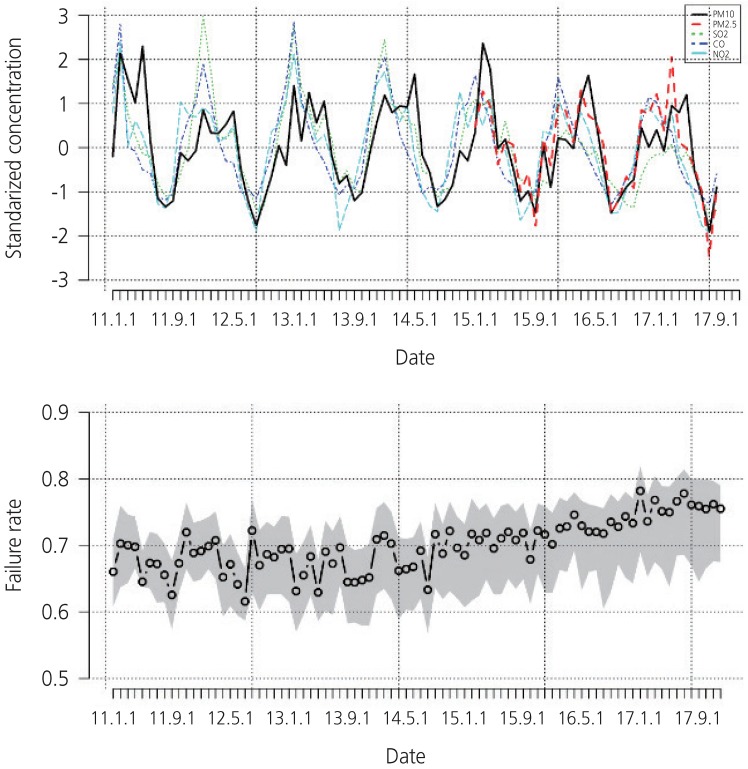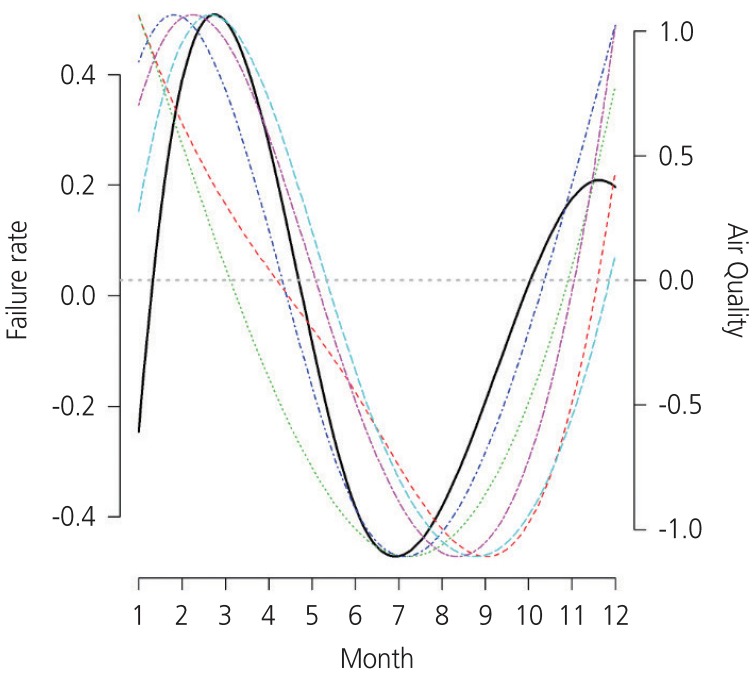Obstet Gynecol Sci.
2020 Jan;63(1):72-79. 10.5468/ogs.2020.63.1.72.
Association between in vitro fertilization success rate and ambient air pollution: a possible explanation of within-year variation of in vitro fertilization success rate
- Affiliations
-
- 1Department of Statistics, Korea University, Seoul, Korea. sjshin@korea.ac.kr
- 2Department of Environmental Science and Engineering, Ewha Womans University, Seoul, Korea.
- 3Department of Biomedical Science, CHA University, Seongnam, Korea.
- 4CHA Fertility Center, Seoul Station, CHA University, Seoul, Korea. jayeon_kim@chamc.co.kr
- KMID: 2467934
- DOI: http://doi.org/10.5468/ogs.2020.63.1.72
Abstract
OBJECTIVE
To evaluate patterns in air pollution concentrations and in vitro fertilization (IVF) success rates using data from a large, long-term clinical database.
METHODS
We conducted a retrospective cohort study investigating South Korean women who pursued IVF and embryo transfer (IVF-ET) between 2011 and 2017. Hourly concentrations of air pollutants measured at 318 air quality monitoring sites in South Korea between 2011 and 2017 were obtained from the National Institute of Environmental Research. Monthly trends in pregnancy rates and concentrations of air pollutants were assessed.
RESULTS
A total of 34,427 IVF-ET cycles in 18,478 patients were analyzed. The mean age of women at the time of IVF-ET was 36.6 years. The clinical pregnancy rate in the IVF-ET cycle was 30%. Analysis of pregnancy failure rates by month showed that IVF-ET failure rates tended to be higher in March and April and lower in July and August. Concentrations of air pollutants including particulate matter (PM) less than 10 μm in diameter, PM less than 2.5 μm in diameter, sulfur dioxide, nitrogen dioxide, and carbon monoxide were highest in March and April and lowest between July and September.
CONCLUSION
Within-year variations were similar between IVF-ET failure rates and air pollution concentrations based on analysis of a large, long-term database. Specifically, IVF-ET success rates were highest when PM concentrations were lowest. Further studies are warranted to examine the mechanisms accounting for the association between IVF success and air pollutant exposure.
MeSH Terms
-
Air Pollutants
Air Pollution*
Carbon Monoxide
Cohort Studies
Embryo Transfer
Female
Fertilization in Vitro*
Humans
In Vitro Techniques*
Korea
Nitrogen Dioxide
Particulate Matter
Pregnancy
Pregnancy Rate
Retrospective Studies
Sulfur Dioxide
Air Pollutants
Carbon Monoxide
Nitrogen Dioxide
Particulate Matter
Sulfur Dioxide
Figure
Cited by 1 articles
-
The introduction to air pollution on pregnancy outcome (APPO) study: a multicenter cohort study
Young Min Hur, Sunwha Park, Eunjin Kwon, Young-Ah You, AbuZar Ansari, Soo Min Kim, Gain Lee, Mi Hye Park, Kyung A Lee, Soo Jung Kim, Young-Han Kim, Yeon-Sung Jung, Geum Joon Cho, Min-Jeong Oh, Sung Hun Na, Se Jin Lee, Tae Gyu An, Jin-Gon Bae, Yu-Hwan Kim, Soo-Jeong Lee, Na Kyung Kim, Eun-Hee Ha, Young Ju Kim
Obstet Gynecol Sci. 2023;66(3):169-180. doi: 10.5468/ogs.22278.
Reference
-
1. European Environment Agency. Air quality in Europe—2014 report [Internet]. Luxembourg: Publications Office of the European Union;c2014. Available from: https://www.eea.europa.eu/publications/air-quality-in-europe-2014.2. Cosselman KE, Navas-Acien A, Kaufman JD. Environmental factors in cardiovascular disease. Nat Rev Cardiol. 2015; 12:627–642. PMID: 26461967.
Article3. Shah AS, Lee KK, McAllister DA, Hunter A, Nair H, Whiteley W, et al. Short term exposure to air pollution and stroke: systematic review and meta-analysis. BMJ. 2015; 350:h1295. PMID: 25810496.
Article4. Atkinson RW, Kang S, Anderson HR, Mills IC, Walton HA. Epidemiological time series studies of PM2.5 and daily mortality and hospital admissions: a systematic review and meta-analysis. Thorax. 2014; 69:660–665. PMID: 24706041.5. Karakis I, Kordysh E, Lahav T, Bolotin A, Glazer Y, Vardi H, et al. Life prevalence of upper respiratory tract diseases and asthma among children residing in rural area near a regional industrial park: cross-sectional study. Rural Remote Health. 2009; 9:1092. PMID: 19645525.
Article6. Wu J, Ren C, Delfino RJ, Chung J, Wilhelm M, Ritz B. Association between local traffic-generated air pollution and preeclampsia and preterm delivery in the south coast air basin of California. Environ Health Perspect. 2009; 117:1773–1779. PMID: 20049131.
Article7. Takeda K, Tsukue N, Yoshida S. Endocrine-disrupting activity of chemicals in diesel exhaust and diesel exhaust particles. Environ Sci. 2004; 11:33–45. PMID: 15746887.8. Wang J, Xie P, Kettrup A, Schramm KW. Inhibition of progesterone receptor activity in recombinant yeast by soot from fossil fuel combustion emissions and air particulate materials. Sci Total Environ. 2005; 349:120–128. PMID: 16198674.
Article9. Yauk C, Polyzos A, Rowan-Carroll A, Somers CM, Godschalk RW, Van Schooten FJ, et al. Germ-line mutations, DNA damage, and global hypermethylation in mice exposed to particulate air pollution in an urban/industrial location. Proc Natl Acad Sci U S A. 2008; 105:605–610. PMID: 18195365.
Article10. Gao H, Ma MQ, Zhou L, Jia RP, Chen XG, Hu ZD. Interaction of DNA with aromatic hydrocarbons fraction in atmospheric particulates of Xigu District of Lanzhou, China. J Environ Sci (China). 2007; 19:948–954. PMID: 17966851.
Article11. Maluf M, Perin PM, Foltran Januário DA, Nascimento Saldiva PH. In vitro fertilization, embryo development, and cell lineage segregation after pre- and/or postnatal exposure of female mice to ambient fine particulate matter. Fertil Steril. 2009; 92:1725–1735. PMID: 18950758.12. Perin PM, Maluf M, Czeresnia CE, Nicolosi Foltran Januário DA, Nascimento Saldiva PH. Effects of exposure to high levels of particulate air pollution during the follicular phase of the conception cycle on pregnancy outcome in couples undergoing in vitro fertilization and embryo transfer. Fertil Steril. 2010; 93:301–303. PMID: 19631320.13. Mohallem SV, de Araújo Lobo DJ, Pesquero CR, Assunção JV, de Andre PA, Saldiva PH, et al. Decreased fertility in mice exposed to environmental air pollution in the city of Sao Paulo. Environ Res. 2005; 98:196–202. PMID: 15820725.
Article14. Rocha E Silva IR, Lichtenfels AJ, Amador Pereira LA, Saldiva PH. Effects of ambient levels of air pollution generated by traffic on birth and placental weights in mice. Fertil Steril. 2008; 90:1921–1924. PMID: 18222432.
Article15. Missmer SA, Pearson KR, Ryan LM, Meeker JD, Cramer DW, Hauser R. Analysis of multiple-cycle data from couples undergoing in vitro fertilization: methodologic issues and statistical approaches. Epidemiology. 2011; 22:497–504. PMID: 21558857.16. Maity A, Williams PL, Ryan L, Missmer SA, Coull BA, Hauser R. Analysis of in vitro fertilization data with multiple outcomes using discrete time-to-event analysis. Stat Med. 2014; 33:1738–1749. PMID: 24317880.17. Choe SA, Jun YB, Lee WS, Yoon TK, Kim SY. Association between ambient air pollution and pregnancy rate in women who underwent IVF. Hum Reprod. 2018; 33:1071–1078. PMID: 29659826.
Article18. Han EJ, Kim SK, Lee JR, Jee BC, Suh CS, Kim SH. Multiple pregnancy after single or multiple embryo transfer performed according to Korean guidelines. Clin Exp Reprod Med. 2015; 42:169–174. PMID: 26816876.
Article19. de Boor C. A practical guide to splines. New York (NY): Springer-Verlag;1978.20. Carré J, Gatimel N, Moreau J, Parinaud J, Leandri R. Influence of air quality on the results of in vitro fertilization attempts: a retrospective study. Eur J Obstet Gynecol Reprod Biol. 2017; 210:116–122. PMID: 28012404.21. Wood S, Quinn A, Troupe S, Kingsland C, Lewis-Jones I. Seasonal variation in assisted conception cycles and the influence of photoperiodism on outcome in in vitro fertilization cycles. Hum Fertil (Camb). 2006; 9:223–229. PMID: 17190668.22. Stolwijk AM, Reuvers MJ, Hamilton CJ, Jongbloet PH, Hollanders JM, Zielhuis GA. Seasonality in the results of in-vitro fertilization. Hum Reprod. 1994; 9:2300–2305. PMID: 7714148.23. Kirshenbaum M, Ben-David A, Zilberberg E, Elkan-Miller T, Haas J, Orvieto R. Influence of seasonal variation on in vitro fertilization success. PLoS One. 2018; 13:e0199210. PMID: 29975717.24. Tamura H, Nakamura Y, Korkmaz A, Manchester LC, Tan DX, Sugino N, et al. Melatonin and the ovary: physiological and pathophysiological implications. Fertil Steril. 2009; 92:328–343. PMID: 18804205.
Article25. Nobles CJ, Schisterman EF, Ha S, Buck Louis GM, Sherman S, Mendola P. Time-varying cycle average and daily variation in ambient air pollution and fecundability. Hum Reprod. 2018; 33:166–176. PMID: 29136143.
Article26. Legro RS, Sauer MV, Mottla GL, Richter KS, Li X, Dodson WC, et al. Effect of air quality on assisted human reproduction. Hum Reprod. 2010; 25:1317–1324. PMID: 20228391.
Article27. Mao L, Hu M, Pan B, Xie Y, Petersen EJ. Biodistribution and toxicity of radio-labeled few layer graphene in mice after intratracheal instillation. Part Fibre Toxicol. 2016; 13:7. PMID: 26864058.
Article28. Lee CH, Shim HE, Song L, Moon HG, Lee K, Yang JE, et al. Efficient and stable radiolabeling of polycyclic aromatic hydrocarbon assemblies: in vivo imaging of diesel exhaust particulates in mice. Chem Commun (Camb). 2019; 55:447–450. PMID: 30474665.29. Dejmek J, Jelínek R, Solansky' I, Benes I, Srám RJ. Fecundability and parental exposure to ambient sulfur dioxide. Environ Health Perspect. 2000; 108:647–654. PMID: 10903619.
Article30. Murphy KP. Machine learning: a probabilistic perspective. Cambridge (MA): MIT press;2012.
- Full Text Links
- Actions
-
Cited
- CITED
-
- Close
- Share
- Similar articles
-
- A study about fertilization rate following reinsemination in in vitro fertilization
- Improved fertilization rate in human in vitro fertilization with the use of a TEST-York Buffer
- Fetal Cord Serum Supplemented Ham's F-10 vs. Medi-Cult for in Vitro Fertilization Culture Medium
- Study on follicular fluid steroid concentration according to success of in vitro fertilization
- Improvement of pregnancy rate by micromanipulation in human in vitro fertilization: embryo transfer program



